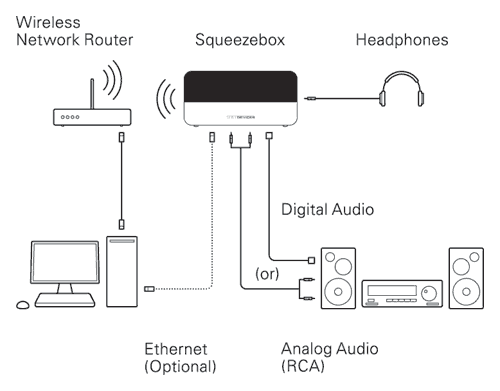
The Squeezebox Squares Off Against The High End, Cont.
It was the wide-ranging support of audio formats that convinced me to have a look at the Squeezebox. In addition to the usual yadi-yada-yah mp3 support, the Squeezebox also supports compressed formats such as AAC, Ogg Vorbis, MP2, MusePack, and WMA. In addition, the Squeezebox offers a choice of lossless formats, including Apple Lossless, FLAC, and WMA Lossless, which provide about a 2:1 compression ratio with supposedly no loss in sound quality. Finally, and perhaps most important to audio high-enders, the Squeezebox also supports uncompressed formats like AIFF, WAV, PCM, with raw pass-through of uncompressed PCM audio formats, including digital pass through to S/PDIF for DTS. Now we’re talking!
By the way, PCM (raw), MP3 (transcoded), or FLAC (transcoded) formats can be streamed from your home base SlimServer to your remote machine at work or wherever using WinAmp or QuickTime players. You get instant access to all your ripped tunes, no matter where you WiFi.
The Squeezebox is a network ready (802.11b/g wireless and/or wired) audio-only player that sports both twin RCA and S/PDIF (optical and coax) outputs. The wireless + wired Ethernet Squeezebox costs $299, while the wired-only version sells for $249. It's available in white or black. And it's small, that’s for sure, measuring just 7.6"W x 3.7"H x 3.1"D. You can network secure the Squeezebox via your choice of WPA Personal, WPA2-AES and 64/128-bit WEP encryption. The little Squeezebox sure hides a lot of goodness. It has a Burr-Brown 24-bit DAC, featuring two dedicated linear power regulators for the DAC and lineout stages.
The brain behind the Squeezebox outfit is a 250 MHz 8-way multithreaded RISC processor. The Squeezebox Network Music Player features "pure software" SlimDSP, a software architecture for providing all audio format decoding and signal processing functionality. The Squeezebox also features native FLAC support in its flash upgradeable firmware. In addition, there is a 64Mbit buffer to withstand various adverse wireless network conditions. All your playlists and music folders are accessible directly from the Squeezebox by using its IR remote.
The IR remote brings up surprisingly easy to use menus on the Squeezebox display. They allow you to quickly drill down to where you want to be. You can also use the remote to jump to favorites, search for albums, artists, or songs. You can even use your Sony PSP or Pocket PC to control both the Squeezebox and the SlimServer. For controlling just the Squeezebox, software is available from Salling Software (Salling Clicker) that enables a Bluetooth enabled cell phone or PalmOS handheld to control the unit. Universal remotes will also work with the Squeezebox. The remote also has a sleep button to turn the Squeezebox off in various 15-minute increments, up to 90 minutes total. When it’s time to wake up, you can set the Squeezebox to act as an alarm clock with your choice of over eighty, get-your-lazy-ass-out-of-bed, environmental and musical sounds.

The Squeezebox also features always-on Internet Radio, powered by SqueezeNetwork, that lets you tune in to Internet Radio streams, even when the computer-hosted SlimServer is switched off. You have a choice from hundreds of Internet Radio streams offered by Slim Devices' partners (including Live365, SHOUTcast, and radioio). Serious listening sound quality varies (mostly sucks, typical for Internet radio) but at least the radio feature is there. There is also an RSS news ticker feed that scrolls across a large, very easy to read, high-resolution vacuum fluorescent display on the Squeezebox. Sporting 320x32 grayscale pixels, the Squeezebox display also offers full-screen visualizers, bitmapped graphics, multiple fonts, animation, images and also a brightness control.
SlimServer, the corresponding software component to the Squeezebox, is based on Open Source software. Not only will SlimServer power any Squeezebox, but it also serves the original SLIMP3 network music player or any software MP3 player on your network. SlimServer runs on Windows, Mac, Linux, BSD and Solaris. You can tell Bill Gates didn’t invest in this company. SlimServer uses any web browser as the user front end, from which you can automatically import Windows and Mac iTunes library and playlists, as well as create, save, and import .pls, .cue and .m3u playlist files, browse and search by title, artist, album or genre, and much more. You can also use 3rd party utilities to automatically retrieve cover art and display it in SlimServer.
Being based on open source, SlimDevices had an opportunity to open up SlimServer to the worldwide developer community, and thankfully, the company took it. It was a brilliant marketing move. The SlimServer/Squeezebox now has a large, thriving open source community providing plug-ins for audio, games, graphics and fonts, skins, diagnostics, XM radio support, tools for making plugin development easier, and more. Tech support is also excellent on the Slim Devices site, with a Wiki, mailing list and forums to keep the geeks and idly curious busy and happy.
21st, The VXM Network, https://vxm.com